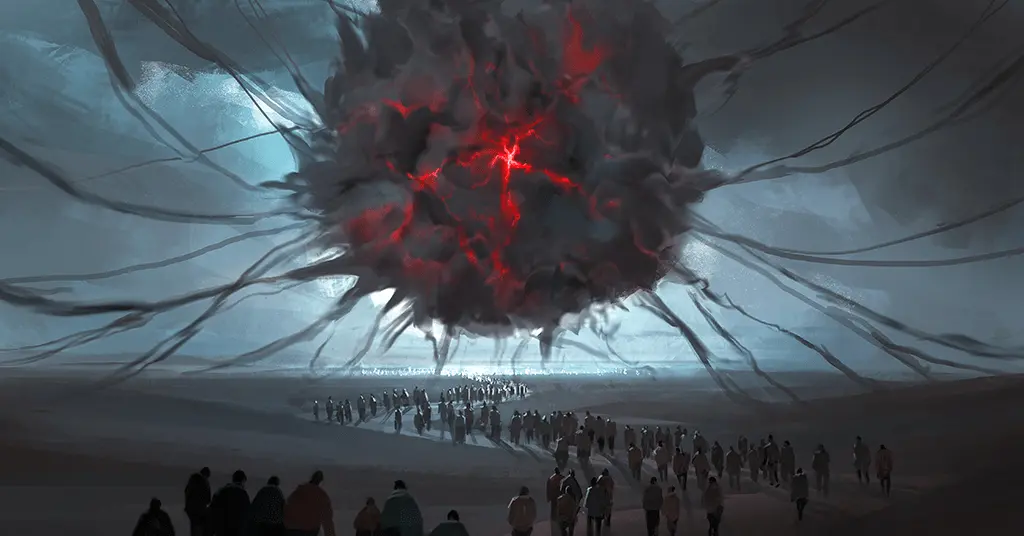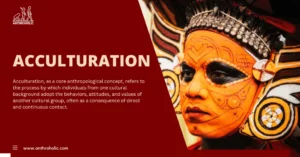AI Answer Evaluation Platform Live Now. Try Free Answer Evaluation Now
Anthropocene
A new epoch known as the Anthropocene is swiftly coming. This notion, which is being studied by climate scientists, geologists, archaeologists, historians, ecologists, and poets, has been embraced by authors, activists, artists, and poets. The deliberations of a mysterious scientific working group and the principles of geological stratification are attentively observed by the media and the general public. Numerous books and studies hypothesize on problems like “freedom,” “art,” or “learning to die” in the Anthropocene, and substantial awards have been presented to publications with names like Adventures in the Anthropocene [1] and The Human Age [2]. In 2011, The Economist’s front page stated, “Welcome to the Anthropocene,” while in 2013, a series of well-attended art shows in Berlin focused on “The Anthropocene Project.”

The sensations that accompany these dialogues vary from fear and hurry to nostalgia for the past to practical problem-solving to optimistic opportunity-seizing. The Anthropocene has grown into a fascinating mega-category that epitomizes the spirit of our time and has taken on a life of its own in both science and entertainment. There is no question that it is a significant aspect of current environmental philosophy, regardless of whether it is a transitory cultural craze or grows into something more substantial. Varied interpretations of the Anthropocene are indicated by the phrase’s various usages, although despite the phrase’s ambiguity, a few common themes typically emerge.
The underlying concept of the phrase is that human activity is substantially impacting a broad variety of components of nature and the functioning of the Earth system, and that this has repercussions for how we view and connect with nature—and how we interpret our role in it. In contrast to earlier terminologies that aimed to represent human impacts on the environment, the name “Anthropocene,” which originates from the Ancient Greek words anthropos (“human”) and -cene from kainos (“new” or “recent”), adopts the official nomenclature of a period of the Geologic Time Scale.
This geological phrase emphasizes the breadth and all-encompassing scope of current environmental changes while drawing attention to their enormous magnitude and significance throughout Earth history.This geological framework, which adds greatly to the power of the expression, gives a way to scientific formalization but also generates rivalry among disciplines. The term, which originated as a concept in the scientific sciences, has since migrated beyond the confines of academia and into the social sciences and humanities, as well as more general cultural and political discussions about how to survive in and deal with the challenges posed by a world dominated by humans. The contemporary vitality of this phrase is partly owed to these more in-depth cultural and philosophical discourses.
Other significant aspects of the chapter include a focus on the global and pervasive nature of the change, b the complexity of global change beyond just climate change, such as species mixing across continents and a decline in biodiversity, c the modification of global biogeochemical cycles, d large-scale resource extraction, and e waste production, and d the two-way interactions between humans and the rest of nature, such that feedbacks can occur at the global, regional, and local levels
A wide range of disciplines, including geology, climate science, earth system sciences, archaeology, history, philosophy, political economy, and social theory, as well as a wide range of timescales, including deep Earth history, prehistoric human history, the emergence of agriculture, the conquest of the Americas by the Europeans, the Industrial Revolution, the modern era, and the near and far future, must be examined. The term’s significance is largely due to how it stimulates and accepts innovative ideas across a broad variety of academic and cultural settings. Because so many academic fields are involved, it is challenging to define the Anthropocene, but it is also a crucial, stimulating, and fascinating subject to talk about because it enables us to comprehend how humans interact with nature and the broader significance and context of the modern environmental challenge.
The Anthropocene Concept’s History
The word “Anthropocene” was first used in the modern period in Crutzen & Stoermer[3] article in the Global Change Newsletter, simply titled “The Anthropocene.” Then, in 2002, Crutzen’s well-known work “Geology of Mankind” was published in Nature, earning considerably greater appreciation and attention. The breadth of human impacts on the Earth system, including climate change but also deforestation, energy consumption, air pollution, fisheries exploitation, and temperature change, were presented in this succinct overview as evidence for the Anthropocene. In its conclusion, it was indicated that significant geoengineering may be necessary to “optimize” the climate. The fundamental concept underlying this initial hypothesis, then, comes from the relatively new field of Earth system science, which studies the Earth as an integrated system, including its physical, biological, chemical, and human social dimensions, using macroscopic tools like in-situ and satellite-based monitoring programmes and computational models of the Earth system.
Even though many of the concepts featured within it are not unique, the manner in which the beliefs were arranged into a single statement and maybe the era during which they were propagated gave them so much credence.
According to Crutzen’[4] original article, the concept of a recent human-dominated period that is materially distinct from its antecedents has been recognized throughout the twentieth century. Most notably, the 1920s coining of the name “Noosphere” by Teilhard de Chardin and Vernadsky, which alludes to the growing capacity of human intellect and action in defining its own future and the planetary environment[5]. Steffen et al.[6] and Lowenthal examine these and other antecedents[7]. According to Hamilton & Grinevald[8], the establishment of an Anthropocene framework was only made practicable in the late 20th century owing to the extant scientific understanding of the full Earth system at that time. They believe that their predecessors had a restricted scope, generally focused on implications for terrestrial ecosystems, and were often saddled with negative notions about progress and inevitability “grounded in stages of consciousness or unlimited economic development.”
The Anthropocene and the Geological Time Scale
Understanding the geologic time scale is critical because the Anthropocene is a geological term used to identify[9]. The history of the Earth has been split into a sequence of hierarchical eons, eras, periods, epochs, and ages on this scale. The greatest level is made up of the four eons, with the Phanerozoic Eon (541 Mya to the present; Greek: “revealed life”) being the most recent. This time range is compatible with the first appearance in the fossil record of hard-bodied multicellular organisms. The Paleozoic, also known as “old life,” began when trilobites and the first land plants and animals first formed. The Mesozoic, often known as “middle life,” began when the renowned age of the dinosaurs first appeared. The Phanerozoic is characterized by periodic catastrophic extinctions, and two particularly dramatic ones divided it into three periods (often referred to as “recent life,” when mammals and birds began to dominate).
These are divided into eras, each of which typically lasts 50 million years. The three eras of the Cenozoic are the Paleogene (or “old recent”; 66–23.03 Mya), Neogene (or “new recent”; 23–2.588 Mya), and Quaternary (2.588 Mya–present). These times are further separated into epochs: Although the latter two Cenozoic epochs are short owing to their closeness to the present, the prior ones generally lasted more than 10 million years
The last officially documented era is the Pleistocene Era (2.588 Mya–11.7 Kya), which is defined by brief interglacial lasting 10-20,000 years. Next is the Holocene Epoch, which began 11,700 years ago[10]). Although it shares many traits with prior Pleistocene interglacial, it differs from them in that agriculture was created, and one species of highly sociable and environment-changing ape witnessed a massive and extremely exceptional population surge. The existence of an agrarian human civilization is consequently included in the Holocene notion[11]. It is possible to create a convincing case that the current era’s alterations signal the start of a new period (the Anthropocene) or even a new era, despite the fact that the Anthropocene is typically believed to be a new geological epoch that follows the Holocene (the Anthropozoic).
The Applied Anthropocene Theory
In the parts that follow, we’ll analyze how various people have exploited the Anthropocene and what they’re aiming to chronicle by doing so. I start by talking about the arguments going on within the scientific disciplines before moving on to more broad viewpoints both inside academia and outside.
The Earth System Sciences’ Perspective
To begin with, Crutzen & Stoermer based their argument that we are living in the Anthropocene on the Earth system sciences. The central thesis of this article is that, as a whole, human activity is changing many aspects of planetary processes and pushing them outside the Holocene’s limited range of variability in favor of a warming trend that is (or soon will be) outside the range of Pleistocene glacial-interglacial cycles.
Climate change is the most evident of these disruptions, but the nitrogen and phosphorus cycles have been considerably accelerated, and ocean acidification is another key disturbance of the planet’s biogeochemistry. Numerous methodologies and measures have been employed to attempt to quantify this predominance of natural biogeochemical cycles, including ecological footprints [12], planetary socio metabolism[13], and human appropriation of net primary production. Planetary frontiers and tipping points on the planets are two examples of potentially harmful thresholds that should be avoided[14]. The planetary limits idea, which may be considered “a specific version of the Anthropocene notion in everything but name,” has acquired a lot of attention in an effort to quantify the basic issue of the growing human footprint.[15]
From the perspective of Earth system sciences, the key feature of the Anthropocene is that human dominance has led to the emergence of feedback between human and nonhuman systems at a planetary scale, such that choices about energy use, land use, food consumption, and trade have an impact on the basic functioning of the planet and may even destabilize it. Human civilizations have always been strongly related to environmental situations at lesser scales, even if substantial feedback at the planetary scale is a defining characteristic of the Anthropocene and a novel worry for policy and governance[16]. This viewpoint maintains that the Anthropocene’s unique feature is the substantial human influence on the climate and biogeochemistry of the planet. Environmental research has provided a different perspective on the nature of the Anthropocene transition. Despite the fact that there is a significant overlap with Earth system viewpoints (which the Earth system sciences perspective emphasizes), this highlights fundamental changes in planetary biodiversity, regardless of whether they have an effect on planetary function. Human activity influences the diversity, distribution, amount, and interactions of life on Earth by the conversion of ecosystems into agricultural or urban “anthromes,” the direct harvesting or exclusion of species, the mixing of species across formerly isolated regions, and environmental change[17]. The patterns of biodiversity are evolving, and this change in how life operates on Earth will likely have long-lasting repercussions that may endure for hundreds of millions of years or more [18].
Even though major species losses may likely result in state shifts in planetary function, it is at least feasible that there may be considerable biodiversity loss without changes in planetary function[19]. Nevertheless, something basic about the Earth would have changed nonetheless. A combination of habitat loss, overharvesting, invasion, and climate change may result in both greater extinction rates and the possibility of a mass extinction. This impending mass extinction is frequently referred to as the “sixth extinction,” which underscores the extent and impact of ongoing changes to the biosphere on both geological and planetary timescales.
Geological Perspective
The Anthropocene notion began in Earth system and environmental sciences, but the majority of formal scientific dispute over its definition has concentrated on geological, and mostly stratigraphic, explanations for it. This geological nomenclature instantly emphasizes that modern environmental changes brought on by human activities should be understood in the perspective of Earth history[20]. The geological debate has typically focused on whether the Anthropocene has a distinguishable stratigraphic signature (see the section below on stratigraphic support for the Anthropocene), which particular signature is most appropriate, and how this influences a decision regarding the Anthropocene’s start date.
The purpose of the geological technique is to establish whether current change is large and detectable over time frames relevant to Earth history. Imagine a geologist (human or extraterrestrial) from the distant future seeking to learn the geological history of our planet. This is a science-fiction-like exercise in thinking . By applying this technique, categorizing the Anthropocene as a geological age is analogous to classifying each of the past geological eras. The preference is for marine or lacustrine deposits, and the emphasis is on stratigraphic markers, which are generally hard-bodied. There is a penchant for universal and accurate dates.
By focusing greater attention on geology, it may be feasible to detach the definition argument from some of the political difficulties and objections (see the Critiques from the Social Sciences section, below) (see the Critiques from the Social Sciences section, below). Therefore, rather than aiming to universally homogenize or divide people according to guilt, it relies on the visible (or maybe observable) geological record for its definition. Feasible road map through this complex variety of viewpoints and themes, this study seeks to consolidate and arrange some of the most essential arguments made in the enormous contemporary literature on the Anthropocene.
Is It Time to Talk About the Anthropocene?
The name “Anthropocene” refers to the view that contemporary human activity has exceeded the fundamental functions of the planet and that, as a result, human social, economic, and political activities have become entwined in a web of planetary feedbacks. Since this extensive global interconnection, which integrates a variety of systems including climate, biodiversity, and biogeochemistry, is unprecedented in the history of humanity and the planet, it deserves a term that covers all of these components. That name appears to be suited for the Anthropocene. It seems to be a sign of a new technique of thinking about systems in science that takes into account how people have affected the planet through time. The way it influences the oldest time periods on Earth also highlights the urgency of present environmental change. Recent scholarship in this subject has tackled a broad variety of difficulties.
According to the Anthropocene, it has allowed new concepts to arise. The study of past human impacts on the natural world and debate on whether we live in a postnatural world both seem to be revitalizing environmental philosophy in a range of academic fields.
Additionally, it perpetuates the belief that humans are a homogeneous species by neglecting the difference and inequality that exist among mankind on a cultural, political, and economic level. The viewpoints of social science must be addressed in the definitions discussion. These points illustrate how helpful the phrase is as a topic of cultural discourse, even if it is challenging to come up with a single statement that can answer all of these problems.
When precisely did it begin?
The idea of the early Anthropocene has led to a reassessment and deeper understanding of the long-standing links between people and their environment. It would be awful to suddenly end this discourse and the spectrum of perspectives it displays. The recent, quick expansion of human effect on planetary functioning has led to the formation of a new link between human history and Earth history. As a consequence, a discernible stratigraphic footprint has been formed that would allow for official chrono stratification. This region significantly determines how useful the Anthropocene is.
It’s crucial to recollect this underlying assumption whenever we talk about start dates: the period at which human impact on planetary function becomes serious. The WGA’s discussion topics suggest that this initial concept remained throughout the industrial period, notably in the middle of the 20th century. Unofficial Paleoanthropocene might be seen as the Anthropocene Is an instructive and useful precursor. Is It Time to Make It Official? The Holocene-Anthropocene transition event, of which we are already in the middle, also looks to better resemble the actuality of considerable predecessors to the mid-twentieth-century Great Acceleration, although when and how this transition would complete would remain rather unpredictable.\sGeological formalization is unimportant in many regards. Outside of the scientific community, the Anthropocene has emerged as a permanent topic, and many of the most compelling debates would persist even if they were defined. The formal frameworks of the geological sciences seem to be cracking under the severe public scrutiny and light to which they are unaccustomed. There are several reasons why the Geologic Time Scale is not fit for this political and cultural paradigm. The most fascinating and creative use of the phrase seeks to represent the concept of human planetary dominance: The stratigraphic signal should not be the principal focus or the message that the phrase is seeking to transmit, even if it is a marker of this moment of Earth system change and is at the center of the geological argument. What brings attention to geology is the geological terminology that has been employed; the phrase’s strength and umbrella-like quality originate from its link to a wider Earth history. What makes the Anthropocene nomenclature unique?
What Does the Future of the Anthropocene Hold?
What matters most in the end is how beneficial the Anthropocene idea is. For thinking about the specific issues that a rising human population on a constrained planet is confronting, it presents a fresh and relevant paradigm. In both intellectual and political discussion, frames are crucial for structuring ideas and generating new patterns of identification and behavior. This article has demonstrated how varied research frameworks, worldviews, and political leanings come into touch with one another while adopting the Anthropocene thinking paradigm, sometimes in positive interaction and other times in uncomfortable but maybe useful friction. There is no dispute that the Anthropocene is stimulating innovative ideas across disciplines. Due to their acceptance in the larger cultural domain, new theories on planetary change and human history are now more frequently understood. The challenges that the globe was addressing are also reflected paired with the mindset of the period. As a result, it could establish a civilizational mindset that allows people to live with one another and on a planet that is under their control.
A new ontology named the Anthropocene
New viewpoints on whether it is vital to address the nature of life on a world governed by people, where human activity is constrained by planetary boundaries and the possibility of nonlinear feedback, have been sparked by the controversy over a new geological era. Understanding and approaching planetary limits, whose breach may result in significant and perhaps permanent changes to the nature of life on Earth, are aspects of the Anthropocene. Numerous dimensions of our techniques of being, thinking, and doing have now been thrown into question by the revealing of planetary restrictions and perhaps damaging feedback. The word “Anthropocene” presents a clear title or context for these challenges, even if it may have evolved independently of the new geopolitics.
Suggested Articles
References
[1] Vince G. 2016. Adventures in the Anthropocene: A Journey to the Heart of the Planet We Made. London: Penguin
[2] Ackerman D. 2014. The Human Age: The World Shaped by Us. New York: Norton
[3] Crutzen PJ, Stoermer EF. 2000. The Anthropocene. Glob. Chang. Newsl. 41:17–18
[4] Crutzen PJ. 2002. Geology of mankind. Nature 415( January):23
[5] Vernadsky W. 1945. The Biosphere and the Noosphere. ¨ Am. Sci. 33(1):1–12
[6] Steffen W, Grinevald J, Crutzen P, McNeill J. 2011. The Anthropocene: conceptual and historical perspectives. Philos. Trans. A. Math. Phys. Eng. Sci. 369(1938):842–67
[7] Lowenthal D. 2016. Origins of Anthropocene awareness. Anthr. Rev. 3(1):52–63
[8] Hamilton C, Grinevald J. 2015. Was the Anthropocene anticipated? Anthr. Rev. 2(1):59–72
[9] Gradstein FM, Ogg JG, Schmitz M, Ogg G. 2012. The Geologic Time Scale 2012. Amsterdam: Elsevier
[10] . Walker M, Johnsen S, Rasmussen SO, Popp T, Steffensen J-P, et al. 2009. Formal definition and dating of the GSSP (Global Stratotype Section and Point) for the base of the Holocene using the Greenland NGRIP ice core, and selected auxiliary records. J. Qt. Sci. 24(1):3–17 https://doi.org/10.1002/jqs.1227
[11] Lewis SL, Maslin MA. 2015. Defining the Anthropocene. Nature 519(7542):171–80
[12] Wackernagel M, Schulz NB, Deumling D, Linares AC, Jenkins M, et al. 2002. Tracking the ecological overshoot of the human economy. PNAS 99(14):9266–71
[13] Malhi Y. 2014. The metabolism of a human-dominated planet. In Is the Planet Full?, ed I Goldin, p. 272. Oxford: Oxford Univ. Press
[14] Steffen W, Richardson K, Rockstrom J, Cornell S, Fetzer I, et al. 2015. Planetary boundaries: guiding ¨ human development on a changing planet. Science 348(6240):1217
[15] Oldfield F, Barnosky AD, Dearing J, Fischer-Kowalski M, McNeill J, et al. 2013. The Anthropocene Review: its significance, implications and the rationale for a new transdisciplinary journal. Anthr. Rev. 1(1):3–7
[16] Barnosky AD, Hadly EA, Bascompte J, Berlow EL, Brown JH, et al. 2012. Approaching a state shift in Earth’s biosphere. Nature 486(7401):52–58
[17] Ellis EC. 2011. Anthropogenic transformation of the terrestrial biosphere. Philos. Trans. R. Soc. A 369:1010–35
[18] Williams M, Zalasiewicz J, Haff P, Schwagerl C, Barnosky AD, Ellis EC. 2015. The Anthropocene ¨ biosphere. Anthr. Rev. 2(3):196–219
[19] Barnosky AD, Hadly EA, Bascompte J, Berlow EL, Brown JH, et al. 2012. Approaching a state shift in Earth’s biosphere. Nature 486(7401):52–58
[20] Davies J. 2016. The Birth of the Anthropocene. Oakland, CA: Univ. Calif. Press




